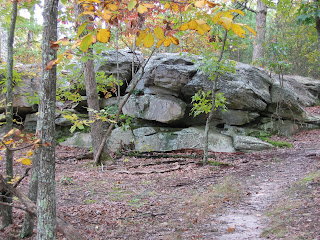On my first trip on the Ozark trail, last summer, I hiked the first 7 and a half miles of the northern-most section of the trail, the Courtois section. I had planned to finish it at spring break but I got sick. So I set out to do it this past weekend.
Two weeks ago I wrote about the storms that had knocked down so many trees in the Paddy Creek wilderness. I turns out that that storm caused widespread damage in south-central Missouri. Many sections of the Ozark trail have had to be closed (many of which I have hiked in the past year) until sawyers can come and clear the dead trees. Fortunately the Courtois section was largely spared, at least the northern portion. So I decided to start about 12 miles into the section (from the southern end) and hike up to the point I had reached last year.
One of the challenges faced by backpackers is transportation. Most trails are "point-to-point" and so you end up a long way from where you parked your car. Rather than using a shuttle service this time I hit on the idea of using my bike. The Courtois section, as you can see below, makes a wide bend and touches (or nearly touches) highway 8 in two places. So I put my bike in the trunk of my car and hid it in the woods near the northern end of the trail and then drove to my starting point. The idea was to hike to the bike (following the blue path on the map below) and then bike to the car (the red path, which follows highway 8). It worked out reasonably well (except for a rainstorm during the biking part of my trip).
View Middle Courtois Section Hike in a larger mapAs near as I can figure the total distance on the trail was 23.7 miles and the biking distance was 8 miles.
Even after having done quite a few backpacking trips over the past year or two I am still a very imperfect backpacker. The one thing I do well is hike. Once I start hiking I become quite taken with the beauty of the forest and it just seems wrong to stop hiking (until it gets too dark to find my way). So I end up doing quite a few miles in a day. This time I started at 1pm or so and did about 19 miles before I stopped to camp. I ended up hiking all the way to my bike on the first day. Part of that is because I hike alone. Hiking alone is really great. But sitting around in camp alone is not much fun. So I tend not to do it much.
Every time I go hiking I think "This one, THIS is the most beautiful section I've ever hiked". It can't really be the case that every trail is more beautiful than the last so I think my memory just fades quickly. But I was very taken with the beauty of this section. Unfortunately most of my pictures didn't turn out (something on the lens I think) but here is a taste of what it was like.

I made a few mistakes, like I do every time. I brought a stove and a hot meal to cook as well as dried snacks to eat along the way. But I never ended up using the stove or the hot meal. It all goes back to preferring to hike rather than sit in camp. And the right kind of snacks can be tasty as well as nutritious. I really like
crunchies freeze dried mixed fruit. No sugar, additives, or preservatives and it's light as a feather and tastes great. I've bought similar stuff from
Just Tomatoes. Their freeze dried mixed veggies is awesome trail food. I also eat a lot of jerky along the trail so I get a pretty balanced diet. And for pure calories (it takes a surprising amount of calories to hike) peanut M&Ms are hard to beat.
My biggest weakness as a backpacker is sleeping. Often I don't sleep at all. Other times I sleep fitfully. If I hike until I'm exhausted I have better luck but still my body needs to have familiar surroundings. So this time I left the hammock at home and tried the air mattress and
bug bivy. It's heavier in the summer than a hammock but it feels more like a bed. My mistake was to look up at the clear night sky and decide that no rain protection was necessary. In the middle of the night I felt drops on my face and quickly threw the poncho/tarp over the bivy. That kept me dry but because it wasn't staked out or supported with trees or poles there was little circulation so I felt pretty clammy when I woke up. Oh well, live and learn.
Next morning I hiked a bit farther up the trail to meet the point I had got to last year and then I went back to camp, got on the bike and headed to my car. That's when the rain really came down. So by the time I arrived at the highway 8 trailhead I was drenched. Then the rain promptly stopped. I hid the bike in the trees, hiked about a mile and half up to my car and drove back to get the bike and go home.
All in all it was a great hike.
















































